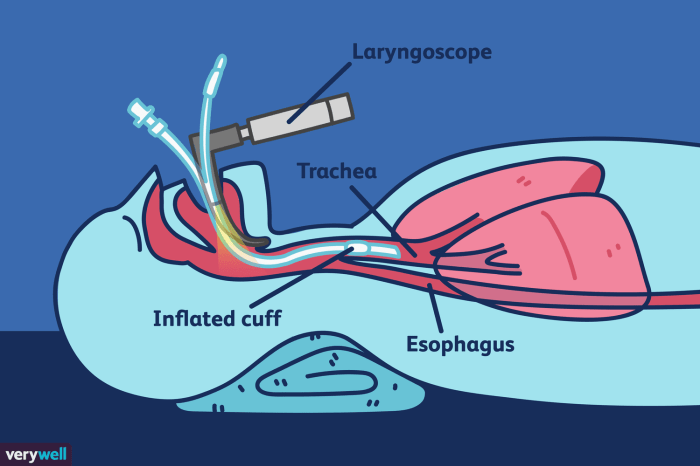When an intubated trauma patient is being transferred, a multitude of factors must be considered to ensure a safe and successful outcome. This article provides a comprehensive overview of the essential aspects of patient assessment, airway management, ventilation and oxygenation, fluid resuscitation, monitoring and management, and transfer considerations for intubated trauma patients.
Understanding the complexities involved in transferring an intubated trauma patient is crucial for healthcare professionals involved in their care. This article aims to equip readers with the knowledge and skills necessary to optimize patient outcomes during this critical phase of their treatment.
Patient Assessment

The initial assessment of an intubated trauma patient should follow the ABCDEs of trauma care:
- Airway: Ensure the airway is patent and secure.
- Breathing: Assess breathing, including rate, depth, and quality.
- Circulation: Check for signs of shock, such as hypotension and tachycardia.
- Disability: Perform a rapid neurological exam to assess level of consciousness and pupillary response.
- Exposure: Remove clothing and examine the patient from head to toe for injuries.
Vital signs to monitor and their target ranges:
| Vital Sign | Target Range |
|---|---|
| Systolic blood pressure | >90 mmHg |
| Heart rate | 60-100 bpm |
| Respiratory rate | 10-20 breaths per minute |
| Oxygen saturation | >95% |
Common physical exam findings and their significance:
| Finding | Significance |
|---|---|
| Jugular venous distension | May indicate hypovolemia or cardiac tamponade |
| Tracheal deviation | May indicate a tension pneumothorax or mediastinal shift |
| Cyanosis | May indicate hypoxemia or shock |
| Tenderness or swelling over the abdomen | May indicate intra-abdominal bleeding |
Airway Management

Maintaining a secure airway is crucial in intubated trauma patients.
- Endotracheal intubation is the preferred method of airway management in trauma patients with an altered level of consciousness or airway compromise.
- Nasotracheal intubation is an alternative method when endotracheal intubation is difficult.
- Laryngeal mask airway (LMA) can be used as a temporary airway adjunct in patients with difficult airways.
Flowchart for managing a difficult airway in an intubated trauma patient:
- Assess the airway and identify any potential obstacles.
- Attempt endotracheal intubation with direct laryngoscopy.
- If direct laryngoscopy fails, use a video laryngoscope.
- If video laryngoscopy fails, consider using a fiberoptic bronchoscope.
- If all other methods fail, consider a surgical airway.
Ventilation and Oxygenation
Mechanical ventilation is often necessary to support breathing in intubated trauma patients.
- Ventilator settings should be adjusted to meet the patient’s specific needs.
- Supplemental oxygen may be required to maintain adequate oxygenation.
Different ventilator settings and their effects:
| Setting | Effect |
|---|---|
| Tidal volume | Volume of air delivered with each breath |
| Respiratory rate | Number of breaths per minute |
| Positive end-expiratory pressure (PEEP) | Pressure applied to the lungs at the end of expiration |
| Inspiratory:expiratory (I:E) ratio | Ratio of inspiration to expiration time |
Use of supplemental oxygen and its potential complications:
- Supplemental oxygen can be delivered via nasal cannula, face mask, or mechanical ventilation.
- Potential complications of supplemental oxygen include oxygen toxicity and hypercapnia.
Fluid Resuscitation: An Intubated Trauma Patient Is Being Transferred

Fluid resuscitation is essential to maintain adequate tissue perfusion in trauma patients.
- Crystalloids (e.g., normal saline, lactated Ringer’s) are the initial fluids of choice for resuscitation.
- Blood products may be required in patients with severe hemorrhage.
Different fluid types and their indications:
| Fluid Type | Indications |
|---|---|
| Normal saline | Hypovolemia without acidosis |
| Lactated Ringer’s | Hypovolemia with acidosis |
| Packed red blood cells | Severe hemorrhage |
| Fresh frozen plasma | Coagulopathy |
Risks and benefits of aggressive fluid resuscitation:
- Aggressive fluid resuscitation can improve tissue perfusion but may also increase the risk of pulmonary edema.
- The optimal amount of fluid resuscitation is individualized and depends on the patient’s clinical status.
Monitoring and Management

Continuous monitoring is essential in intubated trauma patients.
- Parameters to monitor include vital signs, oxygen saturation, end-tidal carbon dioxide, and urine output.
- Common complications to watch for include hypotension, hypoxemia, and arrhythmias.
Management of common complications:
- Hypotension:Administer fluids and vasopressors as needed.
- Hypoxemia:Increase oxygenation, adjust ventilator settings, or consider chest tube placement.
- Arrhythmias:Administer antiarrhythmic medications as needed.
Transfer Considerations
Proper preparation is crucial before transferring an intubated trauma patient.
- Ensure the airway is secure and the patient is adequately ventilated.
- Prepare all necessary equipment and supplies, including suction, monitoring devices, and medications.
- Communicate with the receiving facility to coordinate the transfer and ensure a smooth transition of care.
Checklist of equipment and supplies to be included in the transfer:
- Endotracheal tube and suction catheter
- Ventilator
- Monitoring devices (e.g., pulse oximeter, blood pressure monitor)
- Medications (e.g., vasopressors, antiarrhythmics)
- Chest tube (if indicated)
General Inquiries
What are the key considerations for transferring an intubated trauma patient?
Proper preparation, including equipment and supplies, communication between sending and receiving facilities, and coordination of care.
How should airway management be approached in intubated trauma patients?
Maintaining a secure airway is paramount, with various methods available depending on the patient’s condition and the expertise of the healthcare provider.
What are the principles of fluid resuscitation in trauma patients?
Aggressive fluid resuscitation may be necessary, but it carries potential risks and benefits that must be carefully considered.